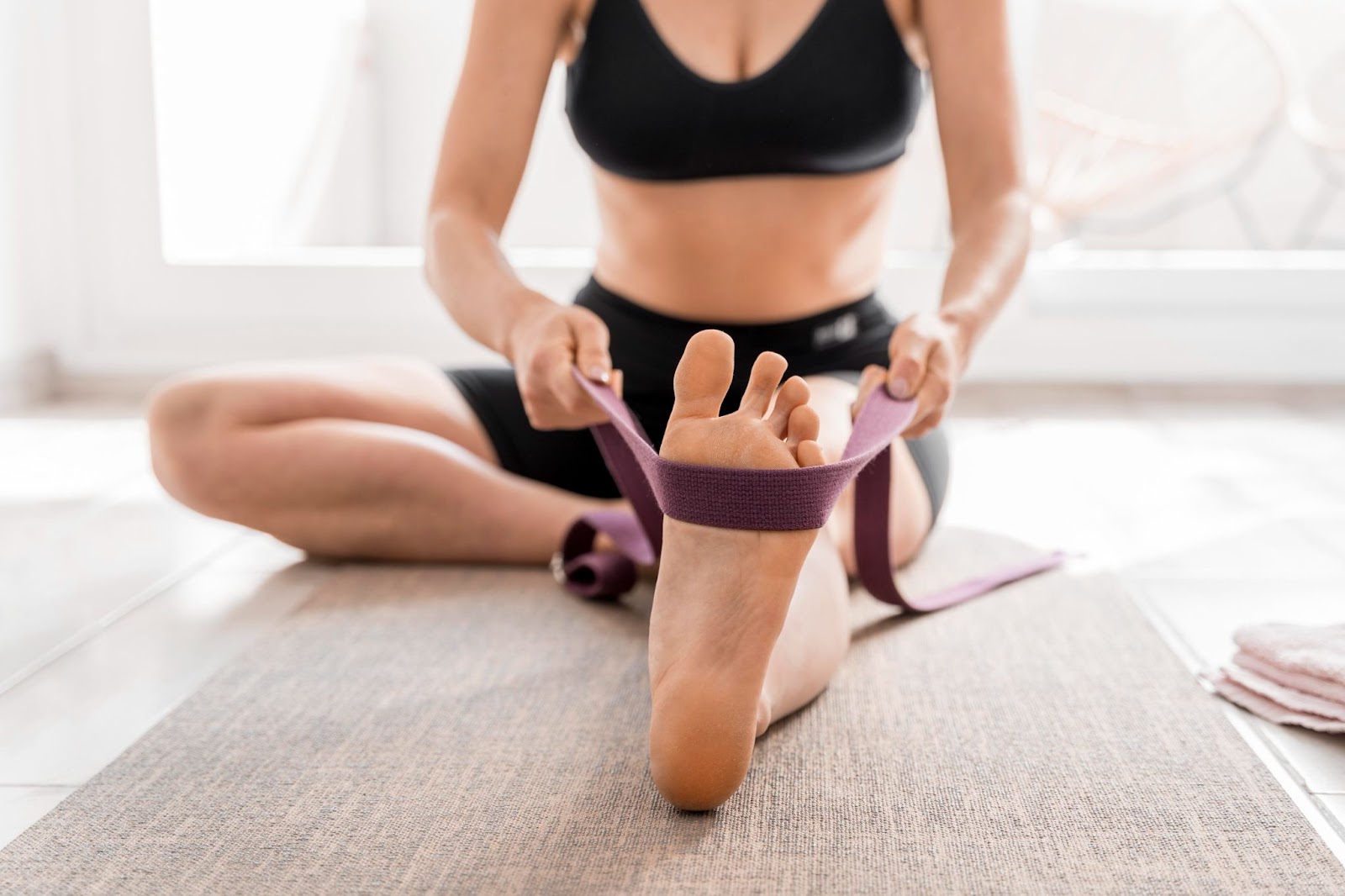Suffering from plantar fasciitis, the persistent ache in your heel, can significantly hinder your day-to-day functions. However, fret not! Within this piece, we are poised to reveal a potent collection of workouts and stretches meticulously crafted to address plantar fasciitis, enabling you to reclaim your mobility without discomfort. Our comprehensive guide encompasses a spectrum of strategies ranging from mild stretches that fortify the relevant muscles to self-massage methods that effectively dissolve accumulated tension. Prepare yourself, lace up your sneakers, as we embark on a journey to bid farewell to heel discomfort!
The Towel Toe Grab: An Effective Exercise for Plantar Fasciitis Relief
Bid goodbye to foot discomfort with an incredibly simple yet effective exercise, affectionately referred to as the Towel Toe Grab. This exercise doesn’t require any fancy equipment; all you need is a towel and a few minutes of your day.
Follow the steps below to perform this exercise correctly:
- Spread a towel flat on the floor;
- Position your left foot on the towel, ensuring your entire foot is in contact with it;
- Concentrate on using your toes and your foot’s arch to clench the fabric of the towel, drawing it towards you. Think of it as ‘scrunching’ your foot and imagine you are using your foot to ‘grab’ the towel;
- After securing the towel with your foot, draw it towards you;
- Perform this movement 15 times with your left foot. This forms a single set;
- Rest momentarily, then switch to your right foot. Repeat the same action for another 15 times;
- Aim to complete three sets for each foot. Ensure to take short breaks between each set.
The Towel Toe Grab targets the muscles and ligaments in your foot, strengthening them over time. Regular practice can result in improved flexibility and reduced pain.
Remember, consistency is key when it comes to exercise. Endeavor to incorporate this exercise into your daily routine for the best results. Always listen to your body, and if any movement causes excessive discomfort, consult with a healthcare professional.
Revitalize Your Feet with Calf Muscle Elevations
One of the most effective ways to ease plantar fasciitis is to strengthen the calf muscles. Calf Muscle Elevations, a simple yet powerful exercise, can help achieve this. Here’s how:
- Choosing the Right Location: First, find an elevated surface like a stair step or an aerobic stepper. Make sure you have a sturdy support structure like a wall or a chair near this location. It’s crucial to have this support for maintaining balance during the exercise;
- Positioning Your Feet: Stand on the step such that your feet are shoulder-width apart with the balls of your feet firmly on the step and your heels extending over the edge;
- Starting the Exercise: Gradually let your heels descend below the balls of your feet. If you need support to keep balance, hold onto the sturdy structure you chose earlier;
- Holding the Position: Maintain this position for a good 2-3 seconds, feeling the stretch in your calf muscles;
- Completing the Movement: Slowly lift your heels to level with your toes, thereby bringing your foot back to the original position;
- Repeating: Perform this movement for a total of 10 times. At this point, you have completed one set of the Calf Muscle Elevations exercise.
Between each set, it’s important to rest and let your muscles recover. Aim to complete three sets in total, but always listen to your body. If the exercise causes discomfort, take a break or consider adjusting the number of repetitions.
Additional Tips:
- Enhance the effectiveness of the exercise by performing it barefoot;
- If you feel an uncomfortable stretch in your calf muscles, reduce the descent of your heels.
Remember, plantar fasciitis relief comes with consistency. Incorporate Calf Muscle Elevations in your daily routine for the best results! Read about the effective techniques and tips for gentle torn meniscus stretching to aid in recovery and regain mobility.
Master the Dome: A Comprehensive Guide to Arch Enhancing Exercises
The exercise colloquially known as “Doming” is specifically designed to strengthen the arch of the foot, providing relief from plantar fasciitis. Here’s a detailed breakdown of this effective exercise:
- Choosing the Ideal Position: Doming can be performed while sitting or standing, offering flexibility based on your comfort level. If you’re just beginning, you might find it easier to try the exercise while seated;
- Preparing Your Foot: Keep your feet flat on the ground. Ensure your entire foot from heels to toes is in contact with the floor;
- Executing the Dome: Without curling your toes, attempt to draw the ball of your foot closer to your heel. This movement should create a ‘dome’ shape as the arch of your foot contracts;
- Maintaining the Position: Hold the ‘domed’ position for a duration of 10 seconds. Feel the muscles around your arch work as they maintain this posture;
- Returning to Start: Slowly release the contraction and let your foot come back to the original position, flat on the ground;
- Repetition: Repeat this movement for a total of 10 times. This completes one set of the Doming exercise.
Like any other exercise, rest and recovery are key to progress. Allow a short break between each set, aiming to complete a total of three sets. Adjust the number of repetitions or sets as per your comfort.
Additional Tips:
- For enhanced efficacy, try performing the exercise barefoot or while wearing comfortable footwear that allows your feet to move freely;
- Pair this exercise with an overall foot care regimen including gentle stretches and a balanced diet rich in calcium and vitamin D for bone health.
Remember, when easing plantar fasciitis, consistency is key. Make the “Doming” exercise a part of your daily routine for maximum results.
Discover the Secret to Foot Health: Arch Stretch with Towels
The Arch Towel Stretch is an effective exercise that targets the plantar fascia, the ligament connecting the heel to the toes, often troublesome in plantar fasciitis. Here’s a step-by-step guide to achieving the perfect arch stretch:
- Setting Up: Begin by positioning yourself comfortably on the floor. Extend your legs straight in front of you;
- Using the Towel: Find a long bath towel and form a loop around the arch of your feet, holding the ends with both hands. Remember to keep your back straight to avoid strain;
- Stretching Your Arch: Keeping your leg straight, carefully pull the towel towards you. You will feel the tension building up in the arch of your foot;
- Holding the Position: Once you feel the stretch, hold this position for about 30 seconds. This pause allows the plantar fascia to extend, promoting flexibility and strength in the ligament;
- Releasing the Stretch: After the pause, gently release the tension and return to your starting position;
- Repeating the Stretch: Aim to replicate this stretch additionally twice, making a total of three repetitions.
Remember to take it easy and monitor your comfort throughout the exercise. Avoid pulling the towel too hard and causing unnecessary stress on your foot.
Helpful Tips:
- Opt for a towel that is sturdy and offers good grip. Ensure the towel isn’t so tight it cuts off your circulation;
- Perform these stretches first thing in the morning to help lessen any stiffness that developed overnight;
- Pair this towel stretch exercise with other foot-friendly activities like walking barefoot on grass, which can also help strengthen the arch and alleviate symptoms of plantar fasciitis.
Add the Arch Towel Stretch to your daily routine and pave your way towards painless foot health.
Unlock Foot Comfort with the Ball Rolling Exercise
The Ball Rolling Exercise is a popular method to alleviate foot discomfort. Although a foam roller is often recommended, a tennis ball can serve as an excellent alternative. Here’s how to effectively perform this exercise:
- Preparing the Equipment: Find an object suitable for rolling under your feet. A tennis ball, due to its size and surface texture, is ideal. A frozen water bottle also works well, with the added benefit of providing a cooling effect that may soothe inflammation;
- Finding a Comfortable Position: Situate yourself in a sturdy chair where your feet comfortably reach the ground. Keep your back straight and feet flat on the floor, parallel to each other;
- Placing the Ball: Position the tennis ball or your chosen rolling object under the balls of your feet. Ensure your heels remain grounded for balance;
- Starting the Exercise: Gently roll the ball under your foot, from heel to toe, applying moderate pressure. Feel the ball massaging your foot arch and the balls of your feet;
- Duration of the Exercise: Aim to continue this rolling motion for a total duration of two minutes per foot.
This exercise offers the double benefit of soothing the plantar fascia while improving circulation in the feet.
Consider These Tips:
- For a more intensive stretch, perform the exercise standing up. This allows for more weight to be applied on the ball, deepening the massage. However, ensure you have support nearby to maintain balance;
- Warm up your feet with light walking or a warm foot bath before performing the exercise to maximize its benefits;
- Regularly switch direction of the roll to stimulate different parts of your foot.
Make the Ball Rolling Exercise a welcome addition to your daily routine. Relieve foot discomfort and step into comfort!
Activate Your Feet with the Marble Pickup Exercise
The Marble Pickup Exercise is a fun and engaging way to strengthen your feet, particularly the arch area, and help alleviate plantar fasciitis symptoms. This step-by-step guide will show you how to perform this exercise:

- Setting Up: Find a comfortable chair to sit on, where you can rest both feet flat on the ground. Make sure your back is straight and relaxed;
- Preparing the Marbles: Arrange a collection of marbles on the floor in front of you. A count of 10-15 marbles is suggested for this exercise. However, if you don’t have that many, you can simply reuse the ones you have;
- Engaging Your Toes: Now, the fun begins! Pick up one marble at a time with your toes. This is achieved by ‘curling’ your toes around the marble;
- Completing the Exercise: Keep picking up marbles until you have retrieved 20. If you started with fewer marbles, simply repeat the process until you reach 20 pickups.
By engaging the muscles and ligaments in your feet, this exercise can significantly enhance foot strength and flexibility.
Consider the Following Tips:
- This exercise can be performed using a variety of small objects. If you don’t have marbles, other objects like pebbles, bottle caps, or small toys can also work;
- For more challenge, try doing the exercise using larger or heavier objects;
- To make the exercise more engaging, turn it into a game by timing how quickly you can pick up all the marbles.
With regular practice of the Marble Pickup Exercise, foot discomfort can be significantly reduced. Make this enjoyable exercise part of your daily routine and experience the difference!
When Plantar Fasciitis Demands a Podiatrist’s Intervention: Don’t Let Heel Pain Hinder Your Steps
Plantar fasciitis, that notorious instigator of heel pain, shouldn’t be left to its own devices. While some cases might respond well to initial home remedies, there are crucial situations where seeking professional help from a podiatrist becomes essential. Here’s why understanding these red flags is vital for keeping your foot happy and healthy:
- The Relentless Stab: Plantar fasciitis pain is characteristically sharp and stabbing, often at its worst during the first steps you take in the morning. But if this pain persists throughout the day, with minimal to no relief, it’s a strong signal to consult a podiatrist. This unrelenting discomfort could indicate inflammation or potential micro-tears in the plantar fascia that require a professional’s touch;
- Escalating Intensity: Pain that progressively worsens over time, despite implementing self-care measures, is a cause for concern. This escalation suggests the underlying issue isn’t being effectively addressed and might even be getting aggravated. A podiatrist can pinpoint the exact source of the pain and create a targeted treatment plan to prevent further damage;
- Spreading Discomfort: Plantar fasciitis pain typically resides in the heel and arch area. However, if the pain starts radiating outwards, involving your toes, ankle, or even calf, it warrants a podiatrist’s evaluation. This radiating discomfort could indicate nerve involvement or biomechanical issues that require a podiatrist’s expertise to diagnose and manage;
- Limited Mobility: Plantar fasciitis can significantly restrict your foot’s range of motion. If you find simple activities like walking or climbing stairs becoming increasingly difficult due to pain and stiffness, don’t hesitate to seek professional help. A podiatrist can assess your mobility limitations and design a personalized rehabilitation program to restore flexibility and function;
- Unexplained Swelling: While some morning stiffness is common with plantar fasciitis, persistent swelling around the heel or arch is not. This swelling could be a sign of inflammation or underlying conditions that a podiatrist can diagnose and address appropriately.
Remember: Early intervention is key! Don’t wait for the pain to become debilitating before seeking professional help. A podiatrist can not only alleviate your heel pain but also prevent future complications and ensure a smooth, pain-free journey for your feet.
Conclusion
Dealing with plantar fasciitis can be quite agonizing, yet with appropriate exercises and stretches, one can attain relief and resume their regular activities. Integrating these exercises into your daily regimen helps in fortifying foot muscles and tissues, enhancing flexibility, and diminishing inflammation. It’s crucial to maintain consistency throughout this process. Should you encounter any discomfort, it’s imperative to cease the exercise and seek advice from a healthcare provider. With patience and determination, conquering plantar fasciitis is possible, allowing you to return to pain-free mobility.


